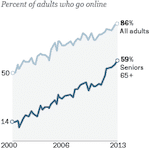Silver Surfers Arise: Prime Audience for Healthcare Marketing
 It may seem counterintuitive, but America’s population of older adults—frequent users of healthcare services—are increasingly frequent users of the Internet. The intersection of senior citizens and the Internet is a growing demographic sweet spot for hospital and healthcare marketing for baby boomers.
It may seem counterintuitive, but America’s population of older adults—frequent users of healthcare services—are increasingly frequent users of the Internet. The intersection of senior citizens and the Internet is a growing demographic sweet spot for hospital and healthcare marketing for baby boomers.
Although younger age groups are more closely associated with technology, gadgets and Internet use, various surveys reveal that between 60 and 70 percent of adults over 65 years old regularly go online. Admittedly the senior stats trail younger demographic segments, but that gap is steadily closing in the US and elsewhere.
A parallel in the United Kingdom, for example, more adults, especially older adults, are going online using a range of devices, according to Ofcom’s Media Use and Attitudes Report 2014. “There has been a nine percentage point increase in those aged 65+ ever going online (42% vs. 33% in 2012).
The UK data also reveals a sharp jump in the use of tablet devices, particularly among seniors. “The number of adults using tablets to go online has almost doubled. While almost all age-groups are more likely to use tablets, use by those aged 35-64 has doubled, while use by 65-74s has trebled; from 5 percent to 17 percent.”
Observation: Unrelated to the UK survey, Pew Research indicates that seniors are more likely to own a tablet or e-book reader than a smartphone.
Insight from within the senior group…

Pew Research
Internet Project
Data from the respected Pew Research Center, released earlier this year, reveals two sharply different groups within the senior segment. With a distinct dividing line around the age of 75, this have-or-have-not gap is a significant planning consideration for healthcare providers and communicators.
“The first group (which leans toward younger, more highly educated, or more affluent seniors) has relatively substantial technology assets, and also has a positive view toward the benefits of online platforms,” Pew reports.
Observation: It’s reasonable to suspect this “connected” crowd is likely to be well insured and/or have the financial wherewithal to address their health care needs, elective or otherwise.
“The other group (which tends to be older and less affluent, often with significant challenges with health or disability) is largely disconnected from the world of digital tools and services, both physically and psychologically.
Observation: Being severely disenfranchised, this segment appears to be largely unreachable via online channels. Because they are older, we suspect, that they may have a greater healthcare need in general. Although these are essentially non-users, the 75-plus group is likely to have friends, family and caregivers who look online for healthcare information.
For additional information and planning considerations, see the complete report: Older Adults and Technology Use.
Related Articles:
Healthcare Marketing to Seniors: How to Create and Distribute on-Target Messaging
The Future of Healthcare Marketing and Digital Dominance
Don’t Alienate the Over-50 Bunch. They’ve Got the Money.









